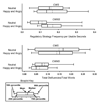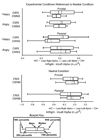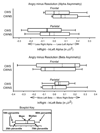Emotional reactivity, regulation and childhood stuttering: a behavioral and electrophysiological study
- PMID: 21276977
- PMCID: PMC3095767
- DOI: 10.1016/j.jcomdis.2010.12.003
Emotional reactivity, regulation and childhood stuttering: a behavioral and electrophysiological study
Abstract
The purpose of this preliminary study was to assess whether behavioral and psychophysiological correlates of emotional reactivity and regulation are associated with developmental stuttering, as well as determine the feasibility of these methods in preschool-age children. Nine preschool-age children who stutter (CWS) and nine preschool-age children who do not stutter (CWNS) listened to brief background conversations conveying happy, neutral, and angry emotions (a resolution conversation followed the angry conversation), then produced narratives based on a text-free storybook. Electroencephalograms (EEG) recorded during listening examined cortical correlates of emotional reactivity and regulation. Speech disfluencies and observed emotion regulation were measured during a narrative immediately after each background conversation. Results indicated that decreased use of regulatory strategies is related to more stuttering in children who stutter. However, no significant differences were found in EEG measurements of emotional reactivity and regulation between CWS and CWNS or between emotion elicitation conditions. Findings were taken to suggest that use of regulatory strategies may relate to the fluency of preschool-age children's speech-language output.
Learning outcomes: The reader will be able to (1) describe emotional reactivity and regulation processes, (2) discuss evidence for or against the relations of emotional reactivity, regulation and stuttering, (3) understand how multiple measures can be used to measure emotional reactivity and regulation.
Copyright © 2010 Elsevier Inc. All rights reserved.
Figures





References
-
- Adams MR. The home environment of children who stutter. Seminars in Speech and Language. 1993;14:185–192.
-
- Alm PA. Stuttering, emotions, and heart rate during anticipatory anxiety: A critical review. Journal of Fluency Disorders. 2004;29(2):123–133. - PubMed
-
- Arends N, Povel DJ, Kolk H. Stuttering as an attentional phenomenon. Journal of Fluency Disorders. 1988;13:141–151.
Publication types
MeSH terms
Grants and funding
LinkOut - more resources
Full Text Sources
Medical

